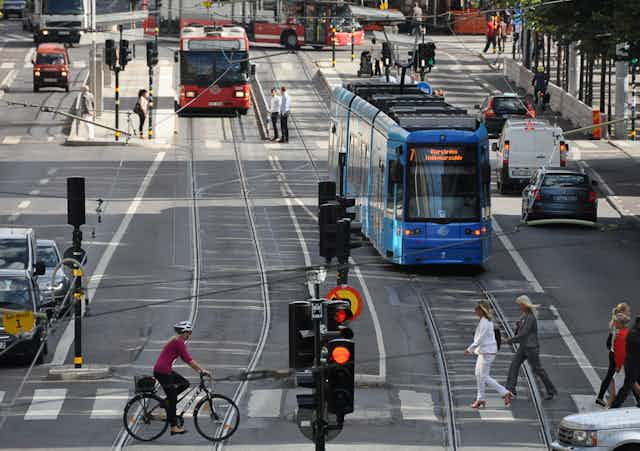Large transport infrastructure projects, which can cost billions of dollars, are major drivers of the economy, and political flagships. They have significant impacts on health and wellbeing. Yet our research finds these impacts are not as well considered in the project assessment phase as they should be.
A recent Lancet series is the culmination of knowledge linking transport and health. For example, it recommends reducing reliance on private cars and enhancing opportunities for walking, cycling and public transport use. It argues this will improve health both by reducing air and noise pollution, and by promoting physical activity, community connectedness and better access to goods and services, particularly for the socio-economically disadvantaged.
Each transport project’s environmental assessment thus presents a crucial opportunity within the mandated planning process to consider health. This is also when the wider community can engage with the design of projects. The main output of this process, the environmental impact statement (EIS), is available for public scrutiny and comment prior to final project approval.
A health check on assessments
We recently compared the inclusion of health issues in four major transport project assessments. Three involved motorways (WestConnex M4 East and NorthConnex in New South Wales and the 2010 Darlington Upgrade in South Australia) and the fourth the Sydney CBD and South East Light Rail. We did this by first applying a “health audit” to each EIS, then interviewing a range of stakeholders.
The road assessments emphasised risks from air quality and noise, concluding these were minimal. Indeed, each project was predicted to improve air quality and, by extension, health.
When health was assessed, human health risk assessment was the method used, which we judged to be of good quality. The 2010 Darlington upgrade was the only road project not to include health data explicitly in its calculations.

The light rail EIS referred mainly to the connection of the project to health facilities, with some reference to noise and dust in construction. This statement’s chapter on social impacts, in which health featured strongly, reflects the tone of the recent Lancet report, albeit with less detail. It considered wider health benefits of the project, including better access to health facilities and employment opportunities, improved road safety, opportunities for walking and cycling, better air quality and enhanced social interaction.
Of the four environmental impact statements, WestConnex M4 East had the most detailed coverage of mental health issues, mostly related to property acquisition. Despite this, there was limited detail in the health chapter when compared to other issues like air and noise risks. Mitigation measures were limited to the provision of phone counselling services.
The EIS for each of the other projects lacked assessment of mental health impacts due to construction and operation.
As outlined above, evidence that links transport and health advocates for access to a mix of transport options, giving people opportunities to walk, cycle and use public transport. The importance of this mix was excluded from the project and parameters set for the two NSW motorway projects.
While the EIS for each of NorthConnex and WestConnex acknowledged the need for multi-modal transport options, their provision was described as being outside the project’s parameters. It wasn’t clear how or when this was being done elsewhere, only that it was not the proponent’s responsibility and not within the scope of the EIS.
This mix of options was minimal in the 2010 Darlington report we analysed. However, the most recent 2016 iteration of this project design appears to emphasise walking and cycling facilities, with a recent announcement of a rail link adjacent to the motorway.
Why were health impacts neglected?
Stakeholder interviews were held with project co-ordinators, consultants, the health department and affected community members for the NSW-based projects. We were unable to conduct interviews for the Darlington case due to changing and uncertain project parameters at the time of the research.
Informants stressed the importance of the requirements issued to proponents by the state Department of Planning and Infrastructure. Health featured in these requirements, largely on the advice of the state Ministry of Health.
These requirements focused on environmental health risks, particularly concerning air quality. This corresponded to historical community concerns about motorway impacts.
Despite an overall consensus that health was an important issue, there was little appetite for comprehensive consideration of broader health impacts, such as those advocated by evidence-based research. Crucially, as reported in the environmental impact statements and confirmed through stakeholder interviews, the design of each project reflects prior financial and strategic decisions. The purpose of the EIS is focused on minimising these risks within those existing design parameters.
Supporting the considerations behind the light rail, there was reference to the cost savings from the health benefits associated with public transport use. This suggests that health was part of that project’s preceding business case. For the motorway projects, however, our research suggests these early decision points failed to comprehensively consider health impacts.
If health is to be comprehensively included in the environmental impact statement, it is clear that it needs to be considered much earlier on when the decisions are made on the parameters of the project. Our findings suggest the design of these projects – from business case to assessment – lags well behind the evidence surrounding transport and health.
The community can be confident that these assessment processes were conducted thoroughly within their set purpose. But the bar for considering the full range of health impacts needs to be raised. This will ensure communities are aware of the long-term impacts of infrastructure provision, and that opportunities to promote and protect health through transport are maximised.

